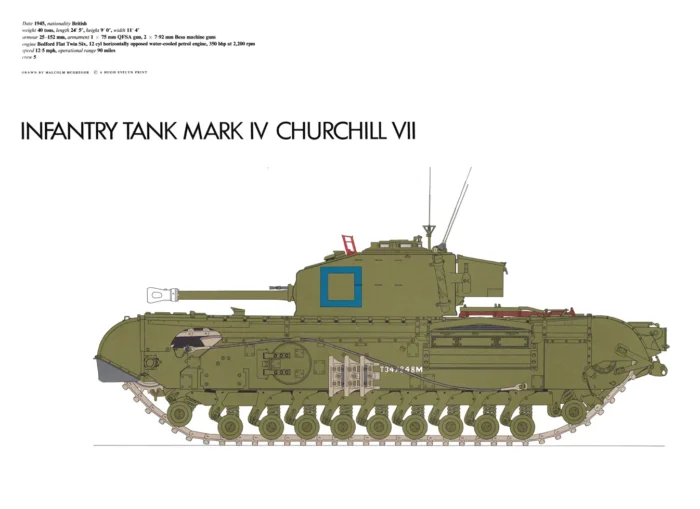AY12 Infantry Tank Mark IV Churchill VII, 1945
£0.00
Infantry Tank Mark IV Churchill VII, 1945 (scroll down for a more detailed Description)
Published 1967 by © Hugh Evelyn Limited; drawn by Malcolm McGregor
Size: c. 47.5 x 34.5 cm [18 ½″ x 13 ½″] may vary slightly from printers’ cut 50 years ago
Printed on white cardstock weighing 140 g/sm2
Print is LARGE size – shipping is the same for 1 to 10 prints (based on largest print size in your order) – see Shipping & Returns
Out of stock
Description
In 1939 a War Office issued a specification for a Matilda successor. From five prototypes this gave led to Infantry Tank Mark IV, known as the Churchill. The order was placed just after Dunkirk when much armour was abandoned. The tank had to be in production within a year. The first fourteen arrived in June the following year. Vauxhall Motors produced the tank, powered by the Bedford horizontal Twin Six engine. When the new 6-pounder gun became available it was fitted to the Mark III in a new welded turret, to be replaced by the medium 75-mm in the Mark IV. Later machines had a five-speed gearbox in place of four. Armour thickness increased, reaching six inches in the Mark VII. Apart from the ill-fated Dieppe raid of August 1942, in which some Mark Is and Ills took part, the Churchill received its battle debut at the second Battle of Alamein, when three Mark IIIs were tested. But it was in Tunisia in 1943 that the tank really proved its serviceability, covering long distances in close country during bad weather. With its slow speed and lack of mobility the Churchill was an inadequate design for use by a fast-moving armoured unit, and in the latter stages of the war its gun power fell short of contemporary German tanks like the Panther and the Tiger. Nevertheless its thick armour proved useful and it was well liked by the British troops, probably because it tended to burn slowly when hit, giving the crew time to bail out. The Churchill proved useful as a mount for special-purpose vehicles: the Crocodile flame-thrower and the mine-clearing tanks. Several chassis were adapted to carry bridging equipment and gave valuable aid to the armoured divisions in crossing rivers quickly during the advance. The Churchill Bridgelayer could place a bridge capable of supporting sixty tons over a 30-ft gap in less than two minutes, using power from the main engine.
Additional information
| Weight | 11.0229 kg |
|---|---|
| Dimensions | 58.5 × 46.5 cm |




